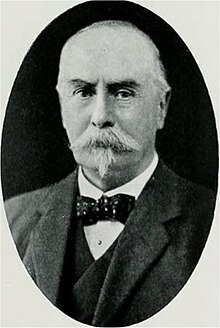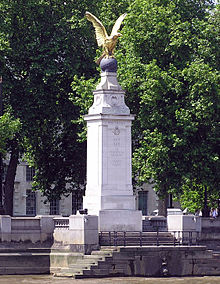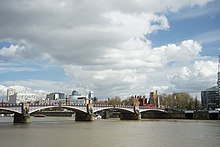Reginald Blomfield
This article includes a list of general references, but it lacks sufficient corresponding inline citations. (February 2011) |

Sir Reginald Theodore Blomfield
Early life and career
Blomfield was born at
Design work
At the beginning of 1884, having completed his training, he left his uncle's office and spent a further four months travelling in France and Spain before returning to London and establishing a practice at 17 Southampton Street, off the Strand, in London;
In 1886 Blomfield married Anne Frances Burra, the daughter of

The heyday of Blomfield's practice, between 1885 and 1914, was dominated by the construction of new
Publications
Blomfield had a gift for sketching and writing. His first book, The Formal Garden in England, illustrated by
His other published works include Studies in Architecture (1905); The Mistress Art (1908), Architectural Drawing and Draughtsmen (1912); The Touchstone of Architecture (1925); Six Architects (1925); Memoirs of an Architect (1932); the controversial anti-
Archival materials
The
List of works
The following list of major works is selected from that given in R.A. Fellows, Sir Reginald Blomfield: an Edwardian architect, 1985, with additions from The Buildings of England and other sources cited in the bibliography:









- Haileybury College, Hertfordshire: erection of Bradby Memorial Hall, 1886; Music School, Sports Pavilion and organ case, 1923
- Broxbourne, Hertfordshire: erection of five houses on St Catherine's estate for J.A. Hunt, 1887
- 20 Buckingham Gate, Westminster, Middlesex: new town house in free Queen Anne style, 1887
- Rye, Sussex: new vicarage, 1887; mission room, 1900
- Swinford Old Manor, near Ashford, Kent: restoration, 1887
- Blacknoll, Dorset: new house, 1889
- Hertford, Hertfordshire: new covered market, public library and art school, 1889 (with W.H. Wilds)
- Brooklands, Weybridge, Surrey: alterations and renovation for Arthur Brook, 1889, in free Queen Anne style
- Rye, Sussex: erection of houses in Gun Garden and Watchbell Street, 1890, 1910
- Aslockton, Nottinghamshire: new church, 1890–92
- Bern (Switzerland): rebuilding of St. Antonien Kapelle, 1891, in late Gothic style
- Carshalton, Surrey: extension of All Saints church, 1891–1914 (with A.W. Blomfield)
- Southwater, Horsham, Sussex: new house and gardens, 1891
- Chequers Court, Buckinghamshire: restoration, alterations and gardens for Bertram Astley, 1892–1901 and Arthur Lee, 1st Baron Lee of Fareham, 1909–12, in neo-Jacobean style
- Frogmore Hall, Hertfordshire: alterations, 1892
- Frognal, Hampstead, Middlesex: new houses at 49–51 Frognal for himself and T.J. Cobden Sanderson, 1892
- Swiftsden, Etchingham, Sussex: new house in neo-Georgian style, 1892
- Borrowstone Lodge, Kincardine O'Neil, Aberdeenshire: new house, 1893
- Caversham, Oxfordshire: chapel, 1893
- St. George, Hanover Square, London: new fittings, circa 1894
- Warley Lodge, Essex: new gardens, 1894
- Mystole House. Chartham, Kent: alterations and additions, 1895, in neo-Georgian style
- Godinton Park, Kent: alterations, 1895, 1924 and new garden, circa 1902
- Greycoat Place, London: warehouse for Army and Navy Stores, 1895
- Limpsfield Chart, Surrey: St. Andrew's Church, 1895, in Arts & Crafts style
- Rye, Point Hill, expansion of cottage into new house for himself, 1895–1912
- Cowley House, Middlesex: addition and alterations, 1896
- Heathfield Park, Sussex: alterations and additions for W.C. Alexander, 1896–1910, in neo-Georgian style
- Lady Margaret Hall, Oxford: college buildings, 1896–1915
- St Edmund's School, Canterbury, Kent: headmaster's house, 1897
- Hillside School, Godalming, Surrey: school buildings and house, 1897
- Wrenaissancestyle
- Mellerstain, Roxburghshire: restoration and gardens for Lord Binning, 1898–1910
- Wrenaissancestyle
- Caythorpe Court, Lincolnshire: new house and gardens for Edgar Lubbock, brewer and banker, 1899–1903, in neo-Jacobean style[6]
- Effordleigh House, near Plymouth, Devonshire: new house, 1899
- Fratton, Portsmouth, Hampshire: St Mary's Church Institute (1899–1907)[7]
- Drakelow Hall, Derbyshire: restoration and gardens for Gresley family, 1900–06
- West Broyle, Chichester, Sussex: new house, 1901
- Yockley, Frimley, Surrey: new house and gardens for Charles Furse ARA, 1901–02 in neo-Georgian style; additional wing, 1910
- Murraythwaite, Dumfriesshire: new house, 1901
- Blundell's School, Tiverton, Devonshire: additions, 1901
- Heywood Manor, Boldre, Hampshire: new house and gardens, 1902
- Euston Hall, Suffolk: new gardens for Duke of Grafton, 1902
- Wrenaissancestyle
- Sherborne School for Girls, Dorset: new buildings, 1902–26, in neo-Tudor style
- Gogmagog Hall, Cambridgeshire: alterations, 1903
- Ballard's Court, Goudhurst, Kent: new house, 1903
- Leasam House, Playden, Sussex: alterations and new gardens, 1903
- Hudson Kearley, 1903
- Apethorpe Hall, Northamptonshire: alterations and additions, and new gardens, for Leonard Brassey, 1st Baron Brassey, 1904
- Knowlton Court, Kent: alterations and new gardens for Major Elmer Speed, 1904
- St Mary's Church, Islington, Portico at west door, 1904
- Merchant Taylors' Hall, London: alterations, 1904, 1926
- Saltcote Place, Rye, Sussex: new house for Mr Hennessy, 1905 | URL=https://www.theargus.co.uk/news/14230958.slice-of-english-history-is-yours-for-35-million/
- Kenfield Hall, Kent: additions and alterations, 1906–09
- Oxford & Cambridge Club, Pall Mall, London: alterations, including new staircase, 1906–12
- United University Club, Suffolk St., London: new building, 1906; extensions, 1924, 1938
- Wyphurst, Cranleigh, Surrey: additions for C.E.H. Chadwyck-Healey, 1907, in neo-Tudor style
- Garnons, Herefordshire: alterations, 1907, in neo-Georgian style
- Ickworth, Suffolk: remodelling of entrance hall for 4th Marquess of Bristol, 1907
- Hill House, Shenley, Hertfordshire: new gardens for S. de la Rue, 1907
- Milner Court, Sturry, Kent: additions and new gardens, 1907
- Moundsmere Manor, Hampshire: new house and gardens for Wilfred Buckley, 1908–09 in neo-Georgian style
- Roehampton, Surrey: new archive repository for Bank of England, 1908–10
- Hill Hall, Essex: alterations and additions for Mrs Charles Hunter, 1909
- Sherborne School, Dorset: Carrington Building, 1909–10; Classrooms and Gatehouse Tower on the northside of the Courts, 1913–23; War Memorial Staircase and ante-Chapel, 1922; Gymnasium, 1923; Music School, 1926
- Manoir de la Trinité, Jersey: remodelling for Athelstan Riley, 1909–12
- Sandhouse, Witley, Surrey: new house, circa 1909–11
- Wrenaissancestyle
- Westgate Water Tower, Lincoln, Lincolnshire, 1910
- 20 Upper Grosvenor Street, London: alterations and redecoration, 1910
- Regent Street/Piccadilly, London: redevelopment of The Quadrant with new shops and stores, 1910–26
- Malma, Pyrford, Surrey: new house, 1914–1915
- Lockleys, Welwyn, Hertfordshire: alterations, additions and gardens, 1911
- Lord Wandsworth College, Hampshire: Entrance to campus, 1912
- Whiteley Village, Surrey: new houses in North Avenue, 1911
- The Lordship, Much Hadham, Hertfordshire: additions, 1912
- Wrenaissancestyle
- Netherseal Hall, Derbyshire: restoration, 1914
- Kinnaird House, Pall Mall, London: new building, 1915 (with A.J. Driver)
- Penn House, Buckinghamshire: alterations, 1918
- Brodick Castle, Arran: restoration and new gardens, 1919
- Harefield Place, Middlesex: alterations, 1920, 1934
- Carlton Club, Pall Mall, London: extension, 1920 (destroyed in Second World War: not the current premises in St James's Street)
- Sulgrave Manor, Northamptonshire: additions and restoration, 1921
- Halstead Hall, Lincolnshire: restoration, 1922
- High Street, Kensington, Middlesex: new department store, 1924
- The Headrow, Leeds, Yorkshire: layout of new street with shops, offices and banks, 1924–37 (with other architects)
- Lambeth Bridge, London: new bridge, 1929–32
- Ypres (Belgium): new British School building, 1925
- Stowe School, Buckinghamshire: development plan, 1926
- Lincoln, Lincolnshire: new building, 1926–27
- Chantry Bridge, Rotherham, Yorkshire: reconstruction, 1927
- Crockerhill, Sussex: alterations, 1929
- County Hall, Lewes, Sussex: rebuilding, 1928–30
- Middlesex Hospital, London: new facade, 1930
- 4 Carlton Gardens, London: new offices, 1932 (part of a scheme for the total redevelopment of Carlton House Terrace
Among war memorials for which he was responsible are:
- , 1915.
- Belgian War Memorial, Victoria Embankment, London, 1917, with Belgian sculptor Victor Rousseau
- Derby School War Memorial, an obelisk at St. Helen's House, Derby, 1921
- Hertfordshire Regiment Memorial, Hertford, 1921
- Ypres (Belgium): Menin Gate, 1922 and Saint George's Memorial Church, 1928
- The Royal Air Force Memorial in London, 1923.
- The Cross of Sacrifice or War Cross, for the Imperial War Graves Commission (now Commonwealth War Graves Commission). These are in Commonwealth cemeteries in many countries.[8]
- Bury War Memorial[9]
Awards and honours
Blomfield was made an Associate of the
Death

He died aged 86 on 27 December 1942 and is buried in family plot in the churchyard of St Michael, Playden, East Sussex, half a mile north of his country home Point Hill, Rye. Fellow architect Horace Field, who was a near neighbour in both Rye and Hampstead, is buried in the same churchyard.
See also
- St. Thomas' Church, Aslockton
References
Notes
Citations
- ^ Highgate School : A Roll [1833-1912] with Names of the Governors, 1565-1912. Headmasters. 1572-1912. Unwin. 1913.
- ^ Historic England. "Details from listed building database (1346210)". National Heritage List for England. Retrieved 30 August 2014.
- ^ "Wittington House Estate - Past, Present and Future: A Unique Location". www.readkong.com. Retrieved 6 May 2022.
- ^ "Reginald Blomfield (1856—1942) architect". Oxford Reference.
- ^ Blomfield, Reginald (1976). "The Tangled Skein: Art in England, 1800–1920". Proceedings of the British Academy, 1919–1920. 9: 375–388.
- ^ "Caythorpe Court, Grantham, England". Parks and Gardens UK. 27 July 2007. Archived from the original on 26 March 2012. Retrieved 14 February 2011.
- ^ Historic England. "247, Fratton Road, Fratton (Grade II) (1104278)". National Heritage List for England. Retrieved 26 December 2017.
- ^ Canadian Encyclopedia Monuments, World Wars I and II
- ^ Historic England. "Bury War Memorial (1444845)". National Heritage List for England. Retrieved 26 December 2018.
Sources
- Blomfield, Sir Reginald (1932). Memoirs of an Architect. London: Macmillan and Co.
- Fellows, R. A. (1985). Sir Reginald Blomfield: an Edwardian architect. London.
{{cite book}}: CS1 maint: location missing publisher (link) - Fellows, R. A. (1995). Edwardian Architecture: style and technology.
- Gray, A. S. (1985). Edwardian Architecture: a biographical dictionary.
- Riddington, Peter; et al. (2001). Regent Street, History and Conservation. London: Donald Insall Associates.
- Service, A. (1977). Edwardian Architecture. London.
{{cite book}}: CS1 maint: location missing publisher (link)
External links
- Profile on Royal Academy of Arts Collections
- Reginald Blomfield: Veterans UK
- Blomfield, Reginald (1911). A History of French Architecture from the Death of Charles VIII till the Death of Mazarin London: G. Bell. Vols. I (copies 1 & 2) and II (copies 1 & 2) at Internet Archive.
- Blomfield, Reginald (1921). A History of French Architecture from the Death of Mazarin till the Death of Louis XV, 1661–1774. London: G. Bell. Vols. I (copies 1 & 2) and II (copies 1 & 2) at Internet Archive.
